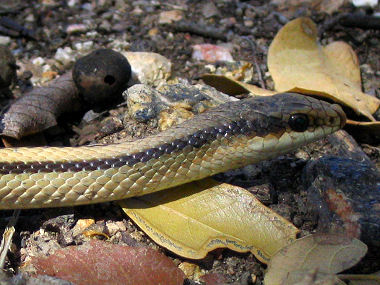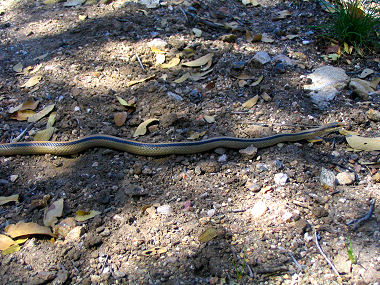The Western Patch-nosed is a medium
length (18 - 46 inches), non-poisonous, slender snake with a wide light
tan or cream colored stripe down the middle of the back (dorsal stripe),
and two darker stripes on each side.
 The
side stripes usually consist of a thick dark stripe above and a thinner
dark stripe below. The belly is usually pale cream. An enlarged rostral
(nose) scale curls up covering the snout. The eyes are large relative to
the size of the head. The snake is found in western and southern Arizona
in flats, foothills, and on mountains from the Sonoran Desert ranging up
into high desert, sagebrush, and juniper/oak woodland. The
side stripes usually consist of a thick dark stripe above and a thinner
dark stripe below. The belly is usually pale cream. An enlarged rostral
(nose) scale curls up covering the snout. The eyes are large relative to
the size of the head. The snake is found in western and southern Arizona
in flats, foothills, and on mountains from the Sonoran Desert ranging up
into high desert, sagebrush, and juniper/oak woodland.
|
Some scientists believe that the
distinctive "patch nose" or enlarged nose scale, is an adaptation
for excavating eggs. |
Western Patch-nosed Snakes are very active in the
daytime, like racers and whipsnakes. They are mostly ground-dwellers and
move rapidly. To regulate their temperature, they may bask in the open
or bury themselves in warm sand. Patchnose snakes regularly feed on the
eggs of lizards and other snakes. They do most of their foraging in the
morning and late afternoon, when lizards are active.
 |

